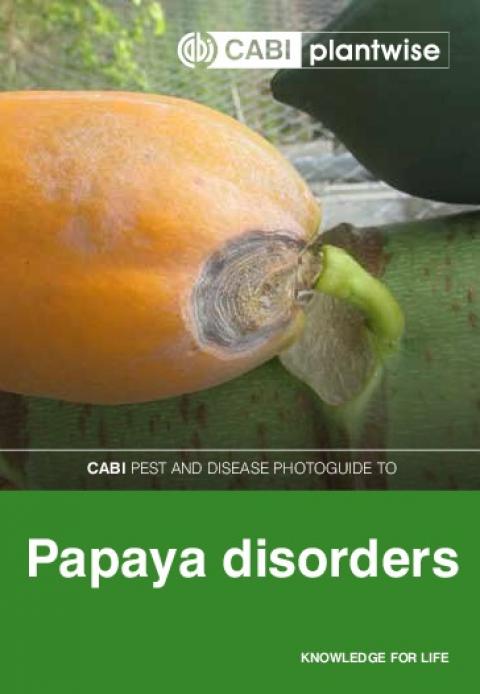KNOWLEDGE FOR LIFE Papaya disorders CABI PEST AND DISEASE PHOTOGUIDE TO
Introduction This photo booklet has been produced by the CABI-led Plantwise programme (www.plantwise.org) to aid extension officers and other plant health advisors in diagnosing the most common pests, diseases and abiotic problems of coffee around the world. The symptoms presented on a real plant sample can be compared with the photos in this guide to identify possible causes. The booklet is organized into two broad sections, one showing the common insect pests that attack the crop and the other showing the various symptoms of poor health. In the symptoms section, the images are arranged by plant part, with similar-looking symptoms displayed together. Some biotic and abiotic factors cause more than one type of symptom, so there may be multiple images in different parts of the photo booklet for a specific problem. The photos for a particular problem are cross-referenced to make it easy to find all the relevant photos.
Contents Sign or symptom Box # Insects and Mites 1–9 Leaf 10–16 Edible portion 17–32 Whole Plant 33–38 Root 39–41
1 Papaya Fruit Fly Toxotrypana curvicauda • Very characteristic insect which lays its eggs through the papaya fruit into hole in the middle of the fruit. • The maggots feed on the developing seeds and fruit in the centre of the fruit. • The mature maggot tunnels out of the fruit and pupates in the soil. • Infested fruits turn yellow and fall early. Photo: Jeffrey W. Lotz, Florida Department of Agriculture and Consumer Services, Bugwood.org 1 INSECTINSECTINSECT BACK TO CONTENTS
2 Oriental Fruit Fly Bactrocera dorsalis • Brown and yellow fly; slightly smaller than a housefly. • Lays eggs below the skin of the fruit. • Larvae (maggots) hatch and feed inside the fruit almost immediatley. • The fruit often falls off and the maggots leave the fruit to pupate in the soil. • This pest is not seasonal, it occurs continuously throughout the year in many areas. Photo: USDA, Flickr 2 25 INSECT BACK TO CONTENTS
3 Citrus Mealybug Planococcus citri • Adult female, pinky/white and covered in wax. • Females suck sap and cause wilting, yellowing and stunting. • The honeydew they produce often leads to sooty mould. • The little white fingers around the insect edge are more obvious than on the Papaya Mealybug. Photo: Charles Olsen, USDA APHIS PPQ Bugwood.org 3 INSECT BACK TO CONTENTS
4 Papaya Mealybug Paracoccus marginatus • Body yellow, covered with wax but this is not thick enough to hide body colour. • Heavy infestations cause distortion of new growth, leaf yellowing, leaf curl and early fall of fruit. • The honeydew they produce often leads to sooty mould. Photo: United States National Collection of Scale Insects Photographs, U\ SDA Agricultural Research Service, Bugwood.org 4 29 INSECT BACK TO CONTENTS
5 White Peach Scale Pseudaulacaspis pentagona • Males and females look quite different and both are pests. • The adult female (shown) cannot move on the plant. Small, circular insect (up to 2mm diameter). Conical in shape there is a darkened tip to the cone. • Males are mobile and appear as tiny grains of rice. Photo: S. Nelson, Flickr 5 17 INSECT BACK TO CONTENTS
6 Snow Scale Unaspis citri • The young (nymphs) are ‘crawlers’ because this is the dispersal stage. Nymphs are oval and bright yellow in colour. • Nymphs form a waxy armour. The snow white armour of the immature male is the reason for the name. The coat has three long ridges; one prominent centre ridge, and one either side. • Immature males are about 1 mm long. Photo: Lisa Ames, University of Georgia, Bugwood.org 6 18 INSECT BACK TO CONTENTS
7 False Spider Mite Brevipalpus phoenicis • Very small, flat reddish; moves around very quickly on the surface of leaves or fruit. Hand lenses are needed. • Can create marks, scarring and sometimes a mosaic on leaf and fruit skin. • Reduces plant vigour and affects the taste of the fruit. Photo: Rayanne Lehman, Pennsylvania Department of Agriculture, Bugwood.org 7 27 21 MITE BACK TO CONTENTS

